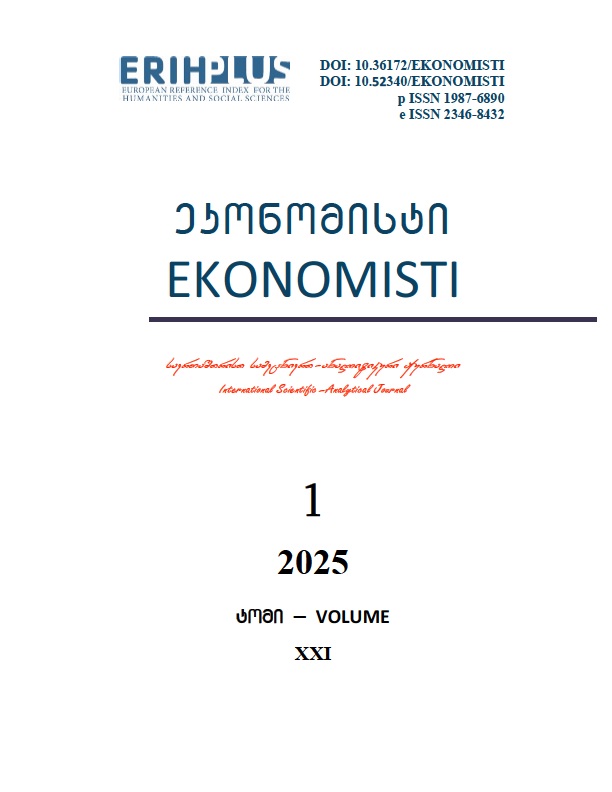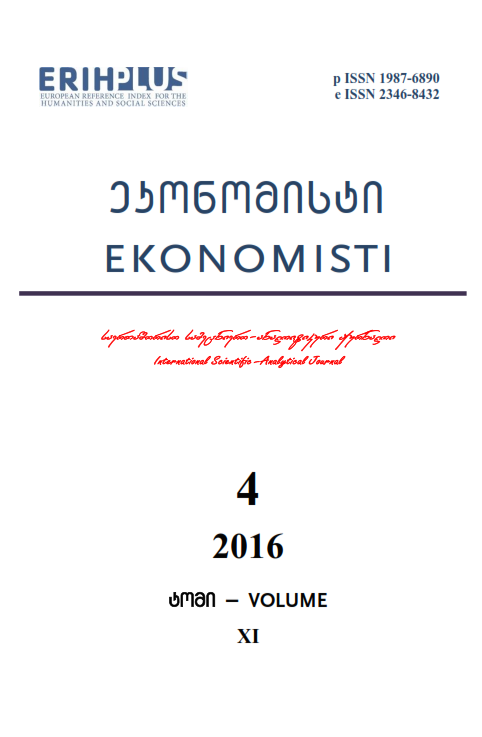
The international scientific and analytical, reviewed, printing and electronic journal of Paata Gugushvili Institute of Economics of Ivane Javakhishvili Tbilisi State University

School of Medicine and Healthcare Management, Caucasus University Challenges of Introducing Critical Incident Reporting System in Georgia
10.36172/EKONOMISTI.2023.XIX.01.TENGIZ.VERULAVA
Expanded Summary
Critical Incident Reporting System (CIRS) have become most common patient safety tools in healthcare. The purpose of this study was to present the development of CIRS in Georgia. A quantitative approach using a cross sectional survey was adopted. The most common critical incidents were due to lack of personal attention and related to individual errors. The most of the critical incidents arise from non-adherence to guidelines and standards. CIRS can be seen as an effective clinical risk management tool that can be used to identify potential sources of critical incidents and help ensure patient safety at a healthcare organization.
Key words: Medical errorsQuality assuranceHealth careRisk managementPatient safety
Patient safety is a specific indicator of the quality of medical care (Hajimohammadi, et al., 2018; Verulava, 2018). Safety is about protecting the patient from the risk of complications, injury, and adverse outcomes. To improve patient safety, many countries have introduced a Critical Incident Reporting System (CIRS) that makes it easier to identify potential harm to a patient (Mitchell et al., 2016). CIRS includes the development of a reporting system in healthcare organizations will focus on error detection, reporting, and training based on these errors, which will not be based on sanctions and punitive actions.
The aim of the study is to determine how effectively CIRS is used and how often critical incidents are detected in a hospital, as well as how well healthcare professionals recognize it as a risk management tool.
Methodology: The study was conducted at the Chapidze Emergency Cardiology Center. For the evaluation of the deployment of the CIRS all available computerized data base and the medical records of critical incident cases reported to Center were studied for the 2015-2019 period. The research design was a descriptive, cross-sectional survey. This was a quantitative approach. Purposive sampling was used to recruit the personnel (managers and clinicians) involved in the CIRS. In total, 196 employees of the center were contacted by e-mail, 181 of which completed and returned a survey (92% response rate). They included doctors (n=52, 29%), nurses (n=95, 52%) and managers (n=34, 19%). Responders were interviewed using a semi-structured questionnaire.
Results: The CIRS is introduced in only one hospital in Georgia. From 2013 to 2019, at the Chapidze Emergency Cardiology Center, the number of incidents recorded in the CIRS increased from 43 to 548, or 13 times. The trainings carried out for the personnel contributed to the annual increase in the number of incidents reported in the CIRS.
The annual increase in the number of reported critical incidents suggests that there are actually more cases, so the number of cases identified in the CIRS is only a small fraction of the actual number of critical incidents. However, due to the fact that the CIRS in Georgia operates only at the Chapidze Emergency Cardiology Center, it is impossible to compare it with medical organizations neither within the country nor in European countries.
The study shows that critical incidents are most often reported by nurses, but doctor participation is growing steadily from year to year. We suggest that continuous training on using CIRS needs a certain period to attract all personnel.
The study shows that the occurrence of critical incidents is mainly associated with the personal responsibility of the staff, namely, with a lack of attention and disregard for existing guidelines and standards, lack of competence. The same results have been obtained in other studies (Hoffmann et al., 2019). Examples of negligence and disregard for standards include the missing or wrong usage of the surgical safety checklist, national and international surgical safety guidelines/protocols, violations of hygiene norms. Failure to comply with guidelines may be due to inadequate, incomplete training of personnel in its principles. In this regard, it is necessary to raise the level of awareness of employees. Inattention can be a sign of stress, lack of knowledge of routine procedures.
Unsatisfactory oral, written, or other form of communication between groups of health care workers also played an important role in the occurrence of critical incidents. The same results have been obtained in other studies (Hohenstein et al., 2016). However, according to other studies, the occurrence of critical incidents is mainly related to medical devices, clinical practice and pharmaceuticals (Welters et al., 2011).
CIRS can be seen as a positive safety enhancement tool that can change the attitude of personnel to risks, increase their vigilance and attention, and awareness of best practices. The study showed that hospital staff adheres to the recommendations of the CIRS, and the effectiveness of the measures carried out is mainly determined through discussion and on-site inspections.
The main obstacle to reporting critical incidents in the CIRS can be a fear of social pressure or punishment in cases where people who have reported the incidents can be identified (Hillen, Pfaff & Hammer, 2017; Okuyama, Wagner & Bijnen, 2014). The concepts of confidence and trust permeated the data, with particular reference to the anonymous and confidential handling of reports (Waring, 2004). In this regard, important are those socio-cultural aspects of medical professionalism that emphasize the significance of collegiality (Premeaux, Bedeian, 2003).
There is yet no real improvement or routine use of CIRS in hospitals throughout the country. One reason could be an insufficient announcement and explanation of the safety reporting system. Another reason may be the fear in personal that any reported incident would cause a backlash disciplinary by the employer (Haller et al., 2011). Whether incident data are disclosable in potential prosecutions, may also play a role (Şalvız et al., 2016). Solution to this problem is to make reports anonymous so that individual clinicians cannot be identified. There is no legal provision to protect reporting people.
CIRS can play an important role in a learning organization by providing the information needed and serving as the basis of a standardized process taken to reduce the number of critical incidents. To do this, all employees must have access to CIRS accounts via intranet or email. The study showed that the employees are informed about the incidents or measures registered in the CIRS mostly through an intranet - a portal accessible for everyone. In addition, periodic collection of critical incidents statistics is required to provide relevant information to hospital managers. Research has shown that reports sent to the CIRS are mostly processed weekly and daily.
This study is very important as there has been no previously published data on CIRS in Georgia. This is the first useful mirror that shows the actual condition of the patient safety and reporting systems in hospitals. In our view, this will shed light on the future establishments of CIRS and improvements.
Conclusion
Systematic analysis of critical incidents is important to reduce medical errors and raise awareness. Research has shown that most of the critical incidents arise from non-adherence to guidelines and standards. Therefore, great attention should be paid to issues such as hand hygiene, the correct application of surgical safety standards. Continuous training of medical personnel is necessary for the further development of the CIRS.

